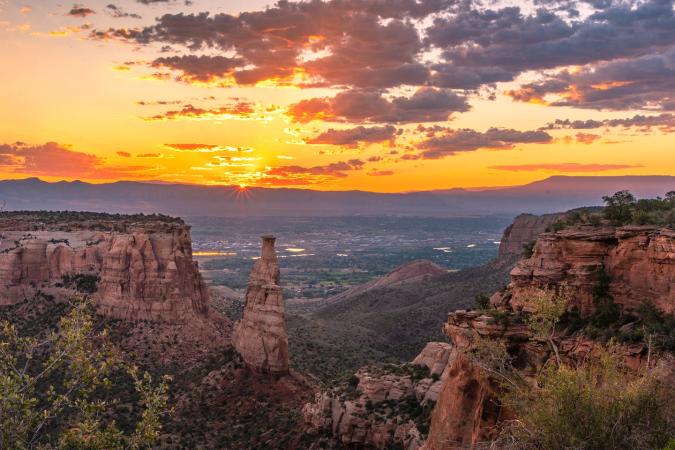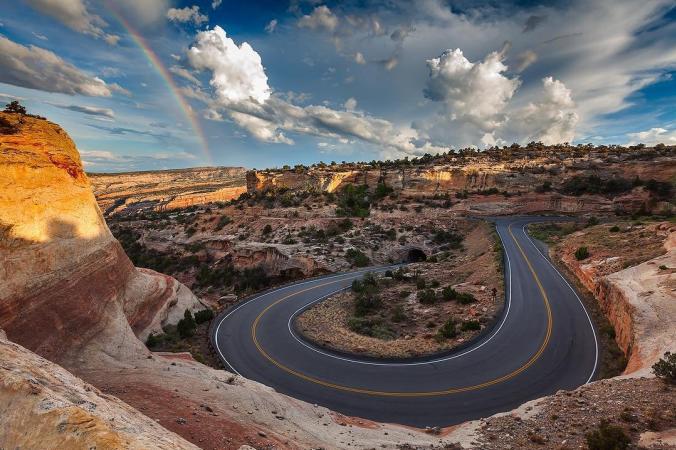3 Minute Read
Grand Junction is famous for the one and only, Nature's Trifecta, which is a combination of three contrasting and unique geographical landscapes that can't be found anywhere else in the world! They include Colorado National Monument, known as the mini Grand Canyon; the Grand Mesa, the largest flat-top mountain in the world with over 300 lakes; and Rattlesnake Arches, the second-most natural arches in the world.
Colorado National Monument earns its spot on Nature's Trifecta thanks to its towering spires, red-rock canyons and distinctive rock formations. Check out why this National Park System wonder is often referred to as the "heart of the world" and "a mini-Grand Canyon."
Located just six miles from Downtown Grand Junction, the rugged, red-rock landscapes of Colorado National Monument have captivated artists, photographers and sightseers for centuries — and for good reason. Around every hairpin turn and tunnel in this 20,500-acre park, you’ll discover wild, Western views that are unlike anywhere else in the world.
1. Rim Rock Drive
Snaking around canyon rims and sheer cliffs, this 23-mile byway is the very definition of a scenic drive. It’s the easiest and most scenic way to explore Colorado National Monument from end to end, whether by car, bike or motorcycle. Consider it hiking in your car! An engineering feat, Rim Rock Drive was hand-carved by the Civilian Conservation Corps in the 1930s, revealing rock layers that date back an astonishing two billion years. You can easily spend days exploring the numerous trails and vistas, from Red Canyon Overlook to Artists Point — a spot favored by plein air painters throughout the years. Keep your eyes peeled for bighorn sheep and golden eagles, two of the species lucky enough to call this place home.
2. Coke Ovens Trail
Less than a mile from Artists Point, pull off at the Coke Ovens Overlook to access one of the grandest views in Colorado National Monument (or anywhere, for that matter). A short, scenic walk leads to a viewpoint of the eponymous Coke Ovens — bulbous, buff-colored pinnacles cut a striking figure against the terracotta-colored canyon. From here, you can take a longer hike on Monument Canyon Trail to get a closer look at the massive rock formations.
3. Stargazing
When the sun sets, a dazzling display of planets, nebulae and constellations light up the sky above, giving the otherworldly terrain an even more lunar-like appearance. While starry skies can be admired from anywhere in the park, the Western Colorado Astronomy Club meets regularly at the Saddlehorn Visitor Center. Most events are free and open to the public, and there are usually plenty of telescopes to give you an up-close view. Check WCACAstronomy.org for events and meetings about astronomy and astrophysics. For additional ways to discover celestial bodies in Grand Junction, check out this blog.
4. Rock Climbing at Independence Monument

John Otto, who became the park’s first ranger after its national monument designation in 1911, was one of the earliest people to climb Independence Monument — a sandstone spire that soars 450 feet out of the canyon floor. Today, you can join the scores of climbers who flock here to see the incredible views from “Otto’s Route” and other climbing routes, which range in difficulty from intermediate to advanced.
SAFETY NOTE: The soft, easily flaked sandstone and vertical sections of Independence Monument present dangers for even experienced climbers. Always use extreme caution and check out the park’s climbing rules and regulations before your visit.
5. Saddlehorn Campground
Perched high above Monument Canyon with sweeping vistas of Grand Junction, Saddlehorn Campground offers views you can normally only dream about. But here, they’re the last thing you see before hitting the sack. A-Loop campsites are open year-round, and are available on a first-come, first-served basis, while the B-Loop is open mid-March through October and can be reserved up to six months in advance. It’s time you camp on top of stunning red rock and stargaze, don’t you think?
6. Ranger-Guided Tours
Get a deeper view of the park, its history and geologic features on a ranger-led tour, departing from the Saddlehorn Visitor Center daily from Memorial Day through Labor Day. Programs range from interpretive hikes to Junior Ranger programs. Be sure to check the park’s online calendar before your visit or stop by the Visitor Center to see what’s on the schedule.
For more dazzling experiences, check out page 16 of the Official Grand Junction Visitor Guide.








